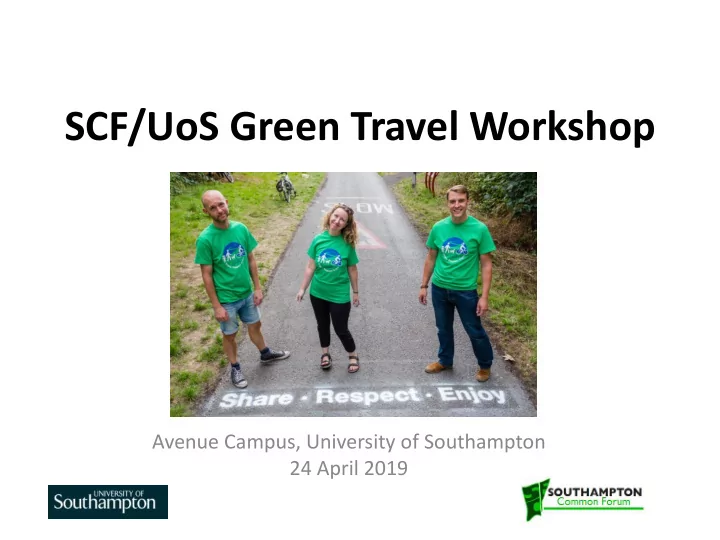

SCF/UoS Green Travel Workshop Avenue Campus, University of Southampton 24 April 2019
Agenda • 07.30: Session I: SCF Research • Roger Brown (Chair) – Best practice: SCF Green Travel & Safety Report (Jenny) – What to users do and think? Survey & Census results (Adam) – Discussion • 08.30: Interval & refreshments • 08.45: Session II: Workshop • Adam Wheeler (Chair) – Workshop session on strategic approach to green travel • 09.30: End
Thank-you Greg Churcher, Southampton City Council • Emily Dawes, SCF • Dave Johnston, SCF • Jenny Marshall, SCF • Adam Tewkesbury, University of Southampton • c. 700 people who contributed their ideas & views • Southampton City Council • University of Southampton • University of Southampton Students’ Union • SCAPPS • Southampton Cycling Campaign, • SUSTRANS • My Journey •
Green Travel and Safety Report Research & Best Practice Jenny Marshall, SCF
Action Plan Priorities • Improve the facilities for green travel and reduce conflicts between pedestrians, cyclists and dog walkers • Improve the safety of users on the Common especially after dark through increasing both the natural light and lighting on the main paths.
Main Paths
How the report was written • GROW methodology: identify best practice elsewhere to explore options. • Informal meetings with key stake holders. • Limitations – Lack of data and evidence to underpin some sections – Literature focuses on urban rather then park environments. – Interesting methodologies
Reduce conflicts between users • Valued public open space for recreation and enjoyment. • Increase in green travel on foot and bike • Space is well shared most of the time. • Conflicts are not as a result of deliberate antisocial behaviour. • Focus on cyclists and pedestrians rather than dog walkers.
Cyclists and pedestrians • Survey shows green travel is second most popular activity on Common. • Conflicts more likely to take place from overtaking than meeting face to face. • Impact of fast cyclists greatest at:- – Peak green travel times – Quiet times – Local pinch points – Vulnerable users
Options to reduce conflicts caused by fast cyclists • Develop and promote a Code of Conduct
Options to reduce conflicts caused by fast cyclists • Provide a commuter cycle path on or beside the Common • Construct physical barriers on paths • Widen selected main paths • Develop segregated, split or separated paths.
Improve safety on the Common on main paths in the light and dark. • Complex area • Perceptions of feeling safe – Good visibility linked to feelings of comfort and security. – Some main paths traverse the open common, others are tightly constrained – Safety factors • First time user; on own or in a group; on wheels or on foot.
Options to improve safety on main paths in the day light • Continue/increase vegetation clearance schedule. • Improve signage especially near entrances. • Promote increased usage as this improves feelings of safety.
Improve safety on main paths in the dark. • Lit paths are: – Highfield Road- Bellemoor – Bellemoor-Northlands Road. – Lovers Walk North • SCC Parks Code: ‘take a sensible approach’ • Improved nature friendly lighting on Common 3 years ago. • Work with the Bat Conservation Trust and UoS.
Options: Improve safety on main paths in the dark • Improve north-south travel by identifying appropriate routes. • Decrease the number of lit paths (space, time or light intensity) • Provide resource to reduce crime and anti - social behaviours.
Short- medium term actions 1. Develop a code of conduct to encourage path users to cooperate. 2. Improve signage and minor infrastructure. 3. Ensure paths are free from intrusive vegetation. 4. Collect and collate data on cyclist and pedestrian travel and motivation on the Common
Medium–long term actions • With users and stakeholders review north- south routes on the Common for travel in darkness. • If the code of conduct initiative is not felt to be effective with users and stake holders explore options 3 (physical constraints at key pinch points) and 4 (widen paths)
Long term action • Develop a framework along the lines of the Royal Parks to assess potential future initiatives on the Common.
Further research • Survey and count fast cyclists. • Find out if:- – codes of conduct are effective. – there is dedicated research about cyclists in parks and commons. – research into path width and cycling in parks – develop and explore bat research.
Southampton Common
Recommend
More recommend